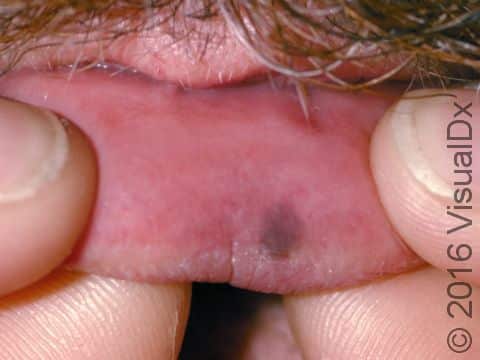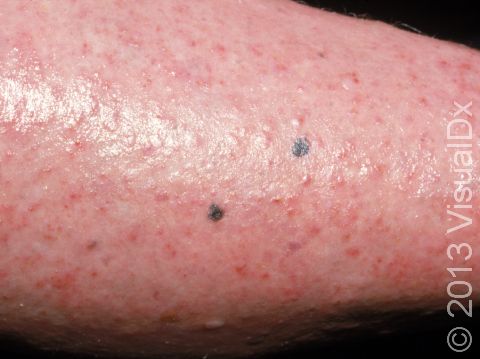Lentigo Simplex
Lentigo simplex is a flat brown spot on the skin that resembles a sunspot (solar lentigo), but it is not caused by sun. In both lentigo simplex and solar lentigo, an increased number of pigment-producing cells, called melanocytes, are present. Lentigo simplex can occur anywhere on the body, though, including areas that are not exposed to sunlight. Single lesions often develop on the lips or on the gums. Multiple lentigos can occur and are sometimes associated with certain rare inherited syndromes.
Who's At Risk?
Lentigo simplex can occur in people of all ages. The lesions usually appear first in early childhood, but they can also be present at birth, or they can develop later in life.
Signs & Symptoms
Lentigo simplex is a macule (small, flat, smooth area of skin), usually 5 mm or smaller in diameter, that can be any shade of brown or can sometimes appear blackish. The macules are usually oval or round, and the edges of the macule may be either smooth or somewhat jagged, with even distribution of color.
Self-Care Guidelines
No self-care is necessary for lentigo simplex.
Treatments
Lentigo simplex is a noncancerous lesion, so no treatment is needed. However, your medical professional may recommend periodic follow-up evaluation or surgical removal of a lesion that is difficult to distinguish from a malignant lesion, such as melanoma.
If there are multiple lentigos, your medical professional may want to do a thorough physical examination and order testing to ensure that there are no further features of the rare syndromes.
If the lentigo simplex is cosmetically bothersome, it can potentially be lightened or removed. The medical professional may recommend topical therapy such as a retinoid and/or hydroquinone. Cryotherapy (freezing the area) or laser treatment are other potential options, although scarring or skin lightening (hypopigmentation) may occur.
Visit Urgency
See a medical professional for evaluation of any pigmented lesion if you are not sure what it is. Although lentigo simplex is harmless, this type of pigmented lesion can appear similar to skin cancers such as melanoma, so it is important to see a medical professional to determine what type of lesion you have.
Trusted Links
References
Bolognia J, Schaffer JV, Cerroni L. Dermatology. 4th ed. Philadelphia, PA: Elsevier; 2018.
James WD, Elston D, Treat JR, Rosenbach MA. Andrew’s Diseases of the Skin. 13th ed. Philadelphia, PA: Elsevier; 2019.
Kang S, Amagai M, Bruckner AL, et al. Fitzpatrick’s Dermatology. 9th ed. New York, NY: McGraw-Hill Education; 2019.
Last modified on June 17th, 2024 at 4:02 pm

Not sure what to look for?
Try our new Rash and Skin Condition Finder

